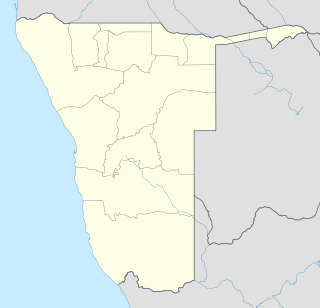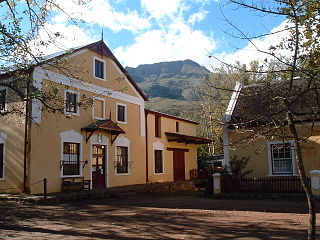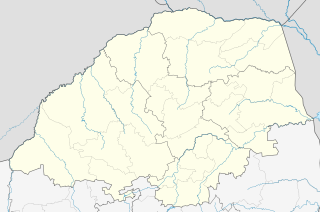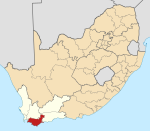This article needs additional citations for verification .(April 2007) (Learn how and when to remove this template message) |
Elim | |
|---|---|
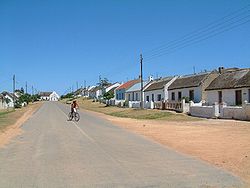 Street in Elim | |
| Coordinates: 34°35′30″S19°45′30″E / 34.59167°S 19.75833°E Coordinates: 34°35′30″S19°45′30″E / 34.59167°S 19.75833°E | |
| Country | South Africa |
| Province | Western Cape |
| District | Overberg |
| Municipality | Cape Agulhas |
| Area | |
| • Total | 28.33 km2 (10.94 sq mi) |
| Population (2011) [1] | |
| • Total | 1,412 |
| • Density | 50/km2 (130/sq mi) |
| Racial makeup (2011) | |
| • Black African | 7.4% |
| • Coloured | 91.6% |
| • White | 1.0% |
| First languages (2011) | |
| • Afrikaans | 94.1% |
| • English | 3.6% |
| • Other | 2.3% |
| Time zone | UTC+2 (SAST) |
| Postal code (street) | 7284 |
| PO box | 7284 |
Elim is a village on the Agulhas Plain in the Western Cape of South Africa. It was established in 1824 by German missionaries as a Moravian mission station. When selecting the location, the missionaries placed a high priority on the proximity of water and on terrain that was suitable for planting vines so that wine for communion could be produced. As well as preaching the Gospel, the missionaries taught the villagers a variety of trades and skills. Elim's thatchers continue to be renowned for their craftsmanship.
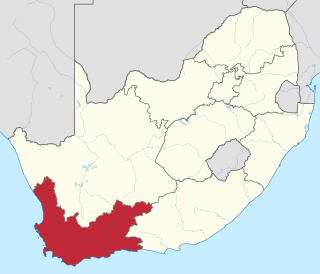
The Western Cape is a province of South Africa, situated on the south-western coast of the country. It is the fourth largest of the nine provinces with an area of 129,449 square kilometres (49,981 sq mi), and the third most populous, with an estimated 6.6 million inhabitants in 2018. About two-thirds of these inhabitants live in the metropolitan area of Cape Town, which is also the provincial capital. The Western Cape was created in 1994 from part of the former Cape Province.

South Africa, officially the Republic of South Africa (RSA), is the southernmost country in Africa. It is bounded to the south by 2,798 kilometres (1,739 mi) of coastline of Southern Africa stretching along the South Atlantic and Indian Oceans; to the north by the neighbouring countries of Namibia, Botswana, and Zimbabwe; and to the east and northeast by Mozambique and Eswatini (Swaziland); and it surrounds the enclaved country of Lesotho. South Africa is the largest country in Southern Africa and the 25th-largest country in the world by land area and, with over 57 million people, is the world's 24th-most populous nation. It is the southernmost country on the mainland of the Old World or the Eastern Hemisphere. About 80 percent of South Africans are of Sub-Saharan African ancestry, divided among a variety of ethnic groups speaking different African languages, nine of which have official status. The remaining population consists of Africa's largest communities of European (White), Asian (Indian), and multiracial (Coloured) ancestry.

Germany, officially the Federal Republic of Germany, is a country in Central and Western Europe, lying between the Baltic and North Seas to the north, and the Alps to the south. It borders Denmark to the north, Poland and the Czech Republic to the east, Austria and Switzerland to the south, France to the southwest, and Luxembourg, Belgium and the Netherlands to the west.
The village is picturesque and has changed little over the years. It is filled with whitewashed cottages, fruit trees and fynbos. All the roads in the village lead to the thatch roofed church. The community, still mainly Moravian, consists of farmers, farm workers and artisans.

Whitewash, or calcimine, kalsomine, calsomine, or lime paint is a type of paint made from slaked lime (calcium hydroxide, Ca(OH)2) and chalk calcium carbonate, (CaCO3), sometimes known as "whiting". Various other additives are sometimes used.

A cottage is, typically, a small house. It may carry the connotation of being an old or old-fashioned building. In modern usage, a cottage is usually a modest, often cosy dwelling, typically in a rural or semi-rural location.

In botany, a fruit is the seed-bearing structure in flowering plants formed from the ovary after flowering.
Elim is becoming known for the export of fynbos, and as an emerging area in the production of wine. [2]

Fynbos is a small belt of natural shrubland or heathland vegetation located in the Western Cape and Eastern Cape provinces of South Africa. This area is predominantly winter rainfall coastal and mountainous areas with a Mediterranean climate. The fynbos ecoregion is within the Mediterranean forests, woodlands, and scrub biome. In fields related to biogeography, fynbos is known for its exceptional degree of biodiversity and endemism, consisting about 80% species of the Cape floral kingdom where nearly 6,000 of them are endemic. This land has faced severe threats and still does, but due to the many economic uses conservation efforts are being made to help restore it.

Wine is an alcoholic drink made from fermented grapes. Yeast consumes the sugar in the grapes and converts it to ethanol, carbon dioxide, and heat. Different varieties of grapes and strains of yeasts produce different styles of wine. These variations result from the complex interactions between the biochemical development of the grape, the reactions involved in fermentation, the terroir, and the production process. Many countries enact legal appellations intended to define styles and qualities of wine. These typically restrict the geographical origin and permitted varieties of grapes, as well as other aspects of wine production. Wines not made from grapes include rice wine and fruit wines such as plum, cherry, pomegranate, currant and elderberry.







